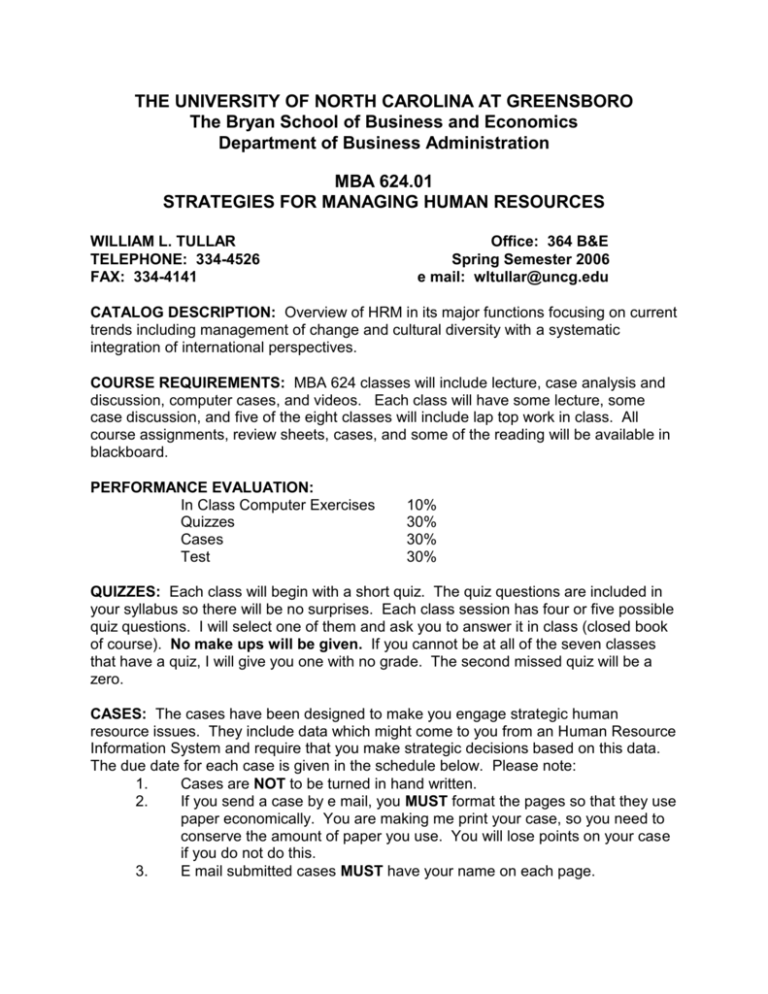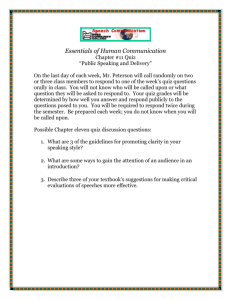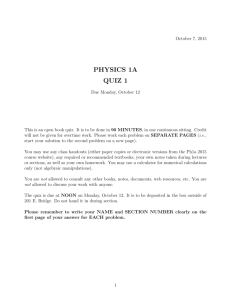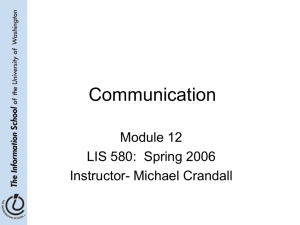Syllabus for Organizational Change and
advertisement

THE UNIVERSITY OF NORTH CAROLINA AT GREENSBORO The Bryan School of Business and Economics Department of Business Administration MBA 624.01 STRATEGIES FOR MANAGING HUMAN RESOURCES WILLIAM L. TULLAR TELEPHONE: 334-4526 FAX: 334-4141 Office: 364 B&E Spring Semester 2006 e mail: wltullar@uncg.edu CATALOG DESCRIPTION: Overview of HRM in its major functions focusing on current trends including management of change and cultural diversity with a systematic integration of international perspectives. COURSE REQUIREMENTS: MBA 624 classes will include lecture, case analysis and discussion, computer cases, and videos. Each class will have some lecture, some case discussion, and five of the eight classes will include lap top work in class. All course assignments, review sheets, cases, and some of the reading will be available in blackboard. PERFORMANCE EVALUATION: In Class Computer Exercises Quizzes Cases Test 10% 30% 30% 30% QUIZZES: Each class will begin with a short quiz. The quiz questions are included in your syllabus so there will be no surprises. Each class session has four or five possible quiz questions. I will select one of them and ask you to answer it in class (closed book of course). No make ups will be given. If you cannot be at all of the seven classes that have a quiz, I will give you one with no grade. The second missed quiz will be a zero. CASES: The cases have been designed to make you engage strategic human resource issues. They include data which might come to you from an Human Resource Information System and require that you make strategic decisions based on this data. The due date for each case is given in the schedule below. Please note: 1. Cases are NOT to be turned in hand written. 2. If you send a case by e mail, you MUST format the pages so that they use paper economically. You are making me print your case, so you need to conserve the amount of paper you use. You will lose points on your case if you do not do this. 3. E mail submitted cases MUST have your name on each page. 2 4. Generally speaking, one sentence answers are LESS than I expect for most questions posed by the case. TEXTS: Gary Dessler, A Framework for Human Resource Management Second Edition (2002) Upper Saddle River, NJ: Prentice Hall.. William L. Tullar, Strategic Human Resource Management. This is found on blackboard. LEARNING OBJECTIVES: 1. 2. 3. 4. 5. 6. 7. 8. 9. 10. The student will explain and illustrate at least three ways in which the human resources of an organization affect the potential strategies the organization can pursue. The student will explain the responsibilities of human resource departments for ensuring that the organization complies with equal employment opportunity and Americans with Disabilities regulations. The student will explain the basic uses of job analysis information and what job and workflow variables should be tracked. The student will explain the recruiting/screening/selection process and their importance to the implementation of strategy. The student will explain the strategic importance of training programs in maintaining and improving employee knowledge, skills, and competencies. The student will explain and illustrate the various performance appraisal data that can be tracked by an HRIS and tell how tracking individual performance helps to improve overall organizational effectiveness. The student will explain the process by which job evaluation data and pay survey data are translated into a coherent pay scale. The student will explain how strategic compensation can be used to further organizational objectives. The student will explain what variables are important to track in maintaining good employee and labor union relations. The student will explain what variables the company must track to comply with OSHA regulations and maintain a satisfactory level of employee safety and health. 3 MBA 624.01 SCHEDULE DATE 1/10/06 1/17/06 1/24/06 TOPIC FOR LECTURE/DISCUSSION READING History of the field; Regulatory environment: Dessler Ch. 1 Strategy and Human Resources Tullar Ch. 1, 2 Quiz Questions: 1. Explain why human resource management is part of every line manager’s job.. 2. Explain the basic differences between line and staff managers. 3. Explain how technology is changing HR.. 4. List and explain two active and two passive verbal behaviors and two active and two passive nonverbal behaviors that are evidenced when people resist change. Case: Trilogy Software Due: 1/17 . Job Analysis & workflows: What to measure Dessler Ch. 2, pp. 65Quiz Questions: 73;106-115 Tullar Ch. 3 1. Outline the two basic provisions of the 1964 Civil Rights Act.. 2. Briefly define Averse Impact and explain the difference between disparate impact and disparate treatment. 3. Explain Bona Fide Occupational Qualification and Business Necessity as defenses against charges of illegal discrimination.. 4. Describe three of the basic methods of collecting job analysis information. 5. Give a brief explanation of reengineering. In Class Computer Exercise: Optimal Assignment at Ajax Automotive Case: Job Analysis Exercise due: 1/24 Recruitment , Selection, & Separation Dessler 73-97; Ch. 4 Quiz Questions: Tullar Ch. 4 1. Contrast the advantages and disadvantages of internal vs. external recruiting. 2. Explain the basic process for forecasting personnel needs. 3. List and briefly describe the different types of data that are necessary to do effective human resource planning.. 4. Distinguish between validity and reliability. 5. Explain what is meant by a Realistic Job Preview. 6. Distinguish between the rule of four-fifths and the two standard deviation rule. In Class Computer Exercise: Selection at Pacific Union Chemical Case: Which recruiting method works? Due: 1/31 4 1/31/06 Training and Development Dessler Ch. 5 Quiz Questions: Tullar Ch. 5 1. Explain how training needs analysis is done. 2. List and explain each of the four training effects that should be measured. 3. Explain the basic tenets of succession planning. 4. Explain the basic objections to using trainee reaction as the sole measure of training effectiveness. In Class Statistics chataqua: Measuring Training Effectiveness Case: Ripem & Runn Due: 2/7 2/07/06 Performance Appraisal and Review Dessler Ch. 6 Quiz Questions: Tullar Ch. 6 1. Explain the difference between forced distribution and alternation ranking. 2. Explain the basic steps of MBO. 3. Distinguish between a halo effect and a central tendency effect. 4. Distinguish between maintenance and achievement as it relates to performance appraisal. In Class Computer Exercise: Performance Dimensions at Bacom & Chipem Case: Performance Improvement Due: 4/25 2/14/06 Compensation Dessler Ch. 7 Quiz Questions: Tullar Ch. 7 1. List and explain the five basic steps involved in setting pay rates for jobs. 2. Explain three methods of job evaluation. 3. Explain the difference between piecework and group incentives. 4. Distinguish between legally required and discretionary benefits. 5. Explain the basic relationship between benefits and employee motivation. In Class Computer Exercise: Costing a hierarchy Case: Norvus Technologies Inc. Due: 2/21 2/21/06 Employee Relations; Fair Treatment Dessler Ch. 8, 9 Quiz Questions: Tullar Ch. 8 1. List and explain the five steps in the process of a unionization drive and election. 2. Distinguish between mediation and arbitration. 3. List and explain the four steps in a disciplinary process. 4. Define wrongful discharge and explain its importance. 2/28/06 Safety and Health Considerations (The TEST will be given at 7:30) Dessler Ch. 10






